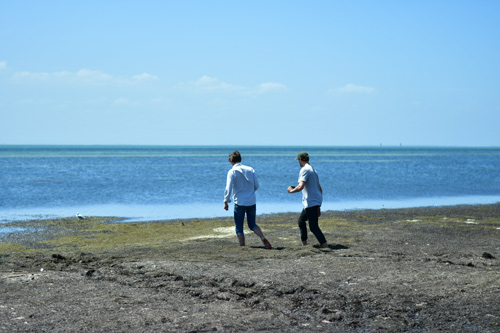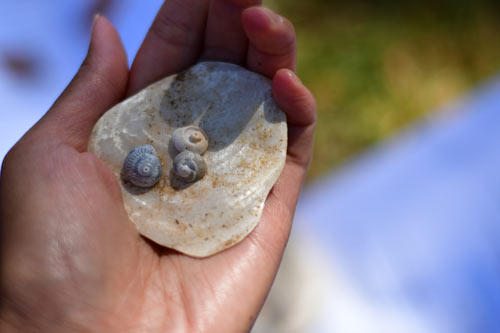Living breakwaters: A reflection
Under the clear, blue skies of a remarkably still day, a group of Citizen Scientists gather on the Portarlington foreshore.
Recent storms have dredged huge amounts of seagrass from the ocean floor onto the beach. The smell of rot is pungent.
We are led by Dr Becki Morris. This site hosts the research Becki is conducting into the effects of nature-based defense systems on coastal health.
We have come to conduct a survey of shells along the beach, and are under specific instructions not to stick our hands anywhere we can’t see. The 30cm-deep covering of seagrass will make this difficult. But it is also evidence that Becky’s 'living breakwater' is doing its job: this amount of grass could only have grown in calm waters.
Today’s data-collection event is a collaboration with Port Phillip Baykeeper Neil Blake, OAM. Neil has been conducting shell surveys for decades. He emphasizes the importance of capturing data on shell diversity, as it is a good indicator of overall marine health.
Because we are at the site of Becky's research, the data we collect today will be particularly significant. It will help to assess the impact of her natural breakwater.
 Bringing together a group of Science alumni invariably results in a diverse range of experience and expertise. We are lucky enough to have some marine biologists among us, who help when shell identification gets more fine-grained than “bivalve or gastropod?”
Bringing together a group of Science alumni invariably results in a diverse range of experience and expertise. We are lucky enough to have some marine biologists among us, who help when shell identification gets more fine-grained than “bivalve or gastropod?”
Geology alumni recall their professor’s golden rule for fieldtrips: always record your data on-site.
We also benefit from the problem-solving abilities of CEOs and managers, who help to delegate transects and tasks.
A part-time Surf Lifesaver reminds me to wear my hat.
We do our best to conduct our survey, picking through the seagrass. We collect the largest shell of each varietal to photograph for Neil’s records, and confer to estimate its frequency.
The process of collection is simple and meditative.
Identifying the samples is tactile and collaborative.
Color is a poor indicator of species, as pigment wears away over time. We are forced to notice idiosyncrasies more acutely than usual. Are these ridges concentric or radial? Is this peak more conical, or more rounded?
In the midst of a climate crisis, there is something soothing about combing the coastline for shells.
 Once we complete our documentation, we return the shells to the beach. Although no longer living, they remain integral to the coastal ecology.
Once we complete our documentation, we return the shells to the beach. Although no longer living, they remain integral to the coastal ecology.
By the time a shell washes onto the beach, what remains of the mollusc might be days or decades old. This singularity makes accurate data on shell distribution crucial, as any variation in distribution could suggest a significant variance in the marine ecosystem.
As with much crowdsourced data, quantity is the key to meaningful impact. Researchers like Neil and Becky need a large amount of data before they can begin to map key trends. The surveys we conduct today will help to build a snapshot of the health of our coastal ecosystem, but they need repeating.
Guest Author: Sophie Bellotti
Our next Science Alumni volunteer day will be held on 28 March 2020 in Portarlington. We would love for you to join us. Read more and RSVP on the event page.